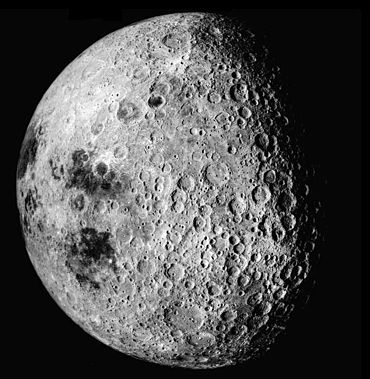
There's a $100 million project underway to bring a telescope that will search for extraterrestrial communications to the far side of the moon.
The International Lunar Observatory Association (ILOA) is spearheading the plan to build a lunar base and research facility on the dark side of the moon, and has teamed up with the commercial space startup Moon Express on the project. Moon Express CEO Bob Richards believes the mission can land a radio telescope on the moon no later than 2018.
While primary goal of the mission is to better understand the cosmos by observing it from the moon, a secondary objective is searching for extraterrestrial life, or SETI. "What drives us is the desire to see humanity as a multi-world species,” ILOA founder Steve Durst told WIRED last month.
SETI researchers are listening for interstellar communication—radio waves and micro waves—to see if anyone out there is transmitting a signal.
Searching for extraterrestrial intelligence by hunting for micro and radio waves in space is an idea that's been around for decades. In a revolutionary 1959 article, "Searching For Interstellar Communications," authors Giuseppe Cocconi and Philip Morrison laid out the methodology and rationale behind the approach:
We shall assume that long ago they [extraterrestrials] established a channel of communication that would one day become known to us, and that they look forward patiently to the answering signals from the Sun... What sort of a channel would it be? The Optimum Channel. Interstellar communication across the galactic plasma without dispersion in direction and flight-time is practical, so far as we know, only with electromagnetic waves.The modern search for aliens has kept intact the logic of the vintage paper. The SETI@home experiment has attracted millions of people to get involved in a search for "narrow-bandwidth radio signals in space," by distributing bite-size pieces of data to be sifted through by ordinary computers.
Anyone can download the software and participate in the search. Nowadays, there are versions of the BOINC software that can run in the background on a smartphone.
The irony is, the very infrastructures that beam those pieces of unprocessed data into the pockets of SETI-curious explorers are interfering with the signals. Our lights and our telecommunications are both born by and contribute to Radio Frequency Interference (RFI) that could obstruct the project to begin with.
As buildings grow toward the stars, increasingly soaking the night skies across the globe in artificial light, putting a radio telescope on the dark side of the moon could be an ingenious solution to that problem. The moon would in effect block the telescope from the radio and electromagnetic noise created by human civilization.
In 2010, Bruno Moretti, the director of SETI Italia "G. Cocconi" (named after Giuseppe Cocconi, the author of the 1959 paper) explained that a lunar-based telescope would sidestep the problem of RFI completely. The far side of the moon—which never faces earth—is the optimal place to set up a radio telescope, he explained. In the next three to four decades, the use of radio telescopes will be far too overwhelmed by manmade interference.
"The largest optical telescopes and astronomy itself, become 'blind' because of light pollution caused by wasteful and irrational use of public lighting, which has been protected in the darkest places on Earth, like the Atacama Desert in Chile and the Hawaiian Islands," Moretti explained in an interview with Seti.cl, a SETI association. The moon, he said, is "naturally radio-protected from human interference with respect to the geostationary satellites."
The possibility of finding aliens, no matter how, may seem far-fetched. And SETI projects might lack a sense of humanist urgency, compared with the other problems facing society. But Cocconi and Morrison left an inspired argument at the end of their article: "The probability of success is difficult to estimate; but if we never search, the chance of success is zero."
By

No comments:
Post a Comment
Note: Only a member of this blog may post a comment.